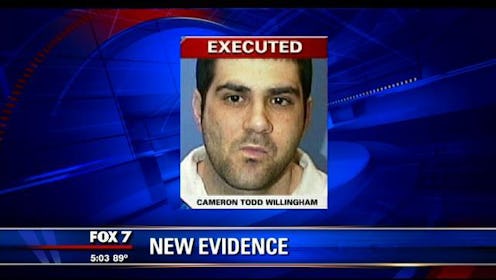News
Was He Innocent, But Executed By Texas Anyway?

Cameron Todd Willingham was executed in Texas in 2009, having been convicted of the arson murders of his three children. But in the years following, a wealth of evidence has suggested that Willingham was innocent of the crime, and wrongly executed. The last few months, with multiple instances of botched lethal injections, have sparked a renewed focus on the issue of capital punishment, and whether it can ever be truly humane. But those stories are about how best to administer execution. Willingham's case, on the other hand, speaks to an even darker question: Can the justice system ever truly be sure enough to reasonably take a life?
Discussion of Willingham's innocence is couched in the theoretical — it's impossible to go back and re-try him, owing to the finality of his punishment. But in the years since his death, a clear picture has emerged of how investigators may have gotten it wrong, how witness testimony may have been corrupted, and how the very institution of arson investigation needed a major overhaul. Here are four things you should know about the death penalty case Rick Perry sure doesn't want you to ask about.
1. There's No Scientific Evidence to Show He Set the Fire
Basically, the conclusions reached by state deputy fire marshal Manuel Vasquez had little, if any, backing in actual, researched fact.
This was laid bare in the months leading up to Willingham's 2004 execution, when Dr. Gerald Hurst was called in to examine the facts presented at trial. Hurst, a longtime arson researcher and one of the foremost minds in America on how fires spread, became aghast when he started examining the records of fire investigators in Texas.
He found that many were no more educationally advanced than high school graduates, and were relying instead on a series of well-worn, handed-down wisdoms and gut-hunches from the previous generation of investigators — hunches that, in simple terms, were wrong. As Hurst explained, in David Grann's terrific longread for The New Yorker in 2009:
People investigated fire largely with a flat-earth approach. It looks like arson—therefore, it’s arson. My view is you have to have a scientific basis. Otherwise, it’s no different than witch-hunting.
The Willingham case was no different — Hurst reviewed Vasquez's findings and testimony and determined that Willingham's conviction had been based on "junk science," relying on perfectly reasonable indications of an accidental fire as proof of a grisly crime.
Completed in 2004, days before Willingham was scheduled for execution, Hurst's report fell on deaf ears, with both the state's Board of Pardons and Paroles and Gov. Rick Perry declining the chance to issue a stay. Hurst told Grann he considered the board's actions "unconscionable."
2. He Wasn't Exactly "Innocent" in Every Way
This is a facet of Willingham's history that's often cited by proponents of his execution — he's alleged to have been a physically abusive husband, having reportedly beaten his wife Stacy on multiple occasions prior to the fire that killed his three daughters. This fact was illustrated strongly by PBS' excellent 2010 Frontline documentary "Death by Fire," which examined the case; Willingham's neighbor recalled the sounds of him assaulting his wife.
This is just one reason that Willingham's case may not seem like a sympathetic one. It's much easier to champion someone's wrongful imprisonment if the person has a sparkling reputation besides the alleged crime, and that wasn't so with Willingham.
But he wasn't charged, convicted and executed for domestic violence. And even if he had been, that crime alone isn't punished by death. Unless you're arguing that domestic violence should be punishable by death, and that it doesn't matter what crime you're actually convicted of, it's no real defense of his execution.
3. He Was an Iron Maiden Fan, and That Mattered
In addition to the testimony of Vasquez, now understood to have been riddled with erroneous claims about the nature of fire and arson, the state's prosecutor made a case on similarly speculative evidence — Willingham's fondness for heavy metal band Iron Maiden was used against him in court. According to Grann, assistant district attorney John Jackson called two experts to assess Willingham's psychology, neither of whom had ever met him.
One, Tim Gregory, focused on an Iron Maiden poster that hung on Willingham's wall, pictured above. He said it evoked "violence" and "death," and commented that, "Many times individuals that have a lot of this type of art have interest in satanic-type activities." In other words, Willingham was hit with a double-whammy — potentially erroneous expert testimony about the fire, then speculation that his taste in music revealed he was a child-murdering Satanist.
4. The Trial May Have Contained False Testimony
On Sunday, dramatic new evidence came to light regarding Willingham's trial, and it suggests possible severe wrongdoing by Jackson. That's because the central witness testimony in the case may have been fraudulent, and evidence now suggests Jackson had a personal interest in helping him out.
As the Washington Post explains, during the trial of another Texas convict named Johnny Webb, he testified that Willingham had confessed the crime to him while the pair were in jail together. He later recanted the testimony, and it's now been revealed that Jackson was in contact personally with Webb, showing an interest in helping him achieve parole and be transferred to a less harsh prison environment.
On July 25, an official grievance was filed with the Texas State Bar against Jackson by nonprofit The Innocence Project. It claimed, according to the Washington Post, that Jackson "violated core principles of the legal profession, and did so with terrible consequences ... the execution of an innocent man." Jackson, for his part, denies the claims as a "fabrication."
Images: Fox, Students Against The Death Penalty/YouTube; Frontline/PBS (5)